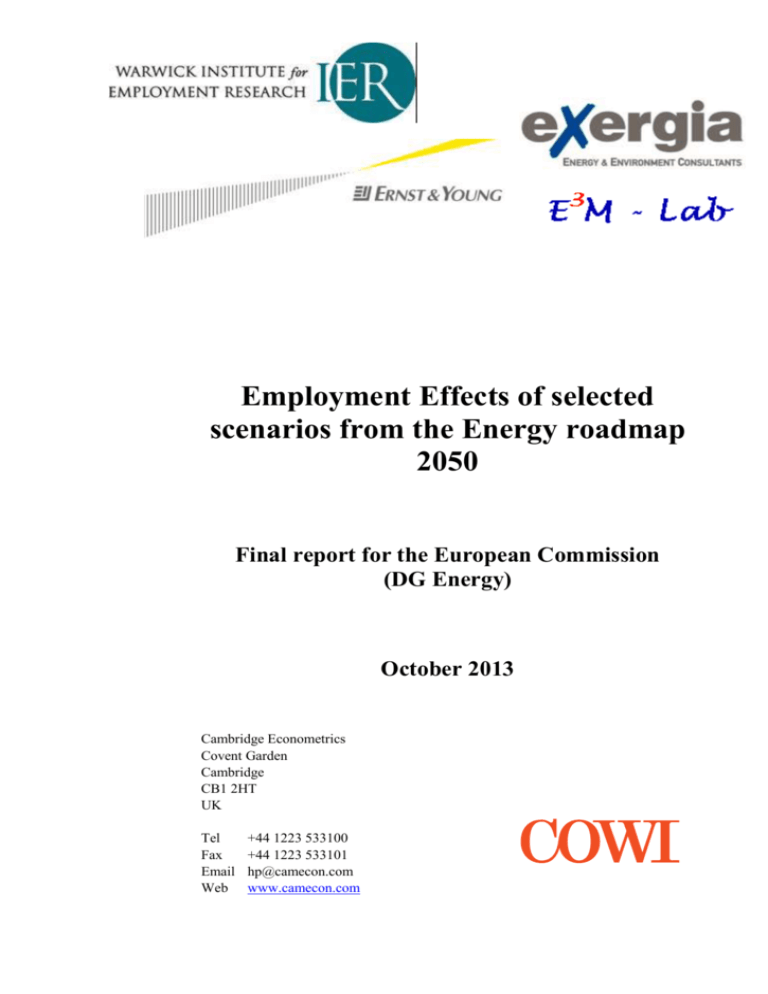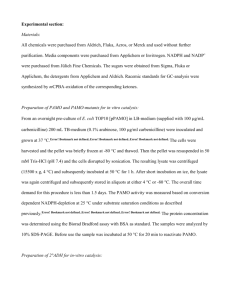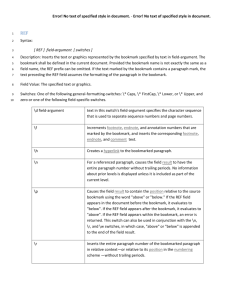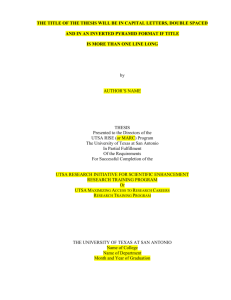Executive Summary
advertisement

Employment Effects of selected scenarios from the Energy roadmap 2050 Final report for the European Commission (DG Energy) October 2013 Cambridge Econometrics Covent Garden Cambridge CB1 2HT UK Tel Fax Email Web +44 1223 533100 +44 1223 533101 hp@camecon.com www.camecon.com Contents Page List of Abbreviations iv Executive Summary v 1 Introduction 1.1 1.2 2 Data Collection 2.1 2.2 2.3 2.4 2.5 3 6 The Energy Roadmap scenarios The baseline The policy scenarios Sensitivities Results from the E3ME Model 5.1 5.2 5.3 5.4 5.5 5.6 Error! Bookmark not defined. Error! Bookmark not defined. Error! Bookmark not defined. Error! Bookmark not defined. Error! Bookmark not defined. Error! Bookmark not defined. Error! Bookmark not defined. Error! Bookmark not defined. Error! Bookmark not defined. Error! Bookmark not defined. Error! Bookmark not defined. Error! Bookmark not defined. Error! Bookmark not defined. Introduction Error! Bookmark not defined. Model development: Incorporating the new dataError! Bookmark not defined. Scenario specification Error! Bookmark not defined. Model results Error! Bookmark not defined. Sensitivity analysis Error! Bookmark not defined. Summary Error! Bookmark not defined. Results from the GEM-E3 Model 6.1 6.2 Error! Bookmark not defined. Error! Bookmark not defined. Introduction Error! Bookmark not defined. Methodological approaches that have been followedError! Bookmark not defined. The DG Employment ‘Green Jobs’ study Error! Bookmark not defined. Energy Roadmap 2050 Error! Bookmark not defined. Focus on specific technologies to 2050 Error! Bookmark not defined. Interaction between the sectors Error! Bookmark not defined. ‘Churn’ and previous cases of rapid technological changeError! Bookmark not defined. Conclusions Error! Bookmark not defined. The Scenarios 4.1 4.2 4.3 4.4 5 Introduction Data sources Methodology Aggregated results for the EU28 Results for the EU28 at country level Review of Previous Literature 3.1 3.2 3.3 3.4 3.5 3.6 3.7 3.8 4 Overview of this report Structure of this report Error! Bookmark not defined. Introduction Modelling methodology Error! Bookmark not defined. Error! Bookmark not defined. Error! Bookmark not defined. 6.3 6.4 6.5 7 GEM-E3 Results on activity and employmentError! Bookmark not defined. Sensitivity analysis Error! Bookmark not defined. Conclusions Error! Bookmark not defined. Detailed Labour Market Impacts 7.1 7.2 7.3 7.4 Introduction Results by skill group Qualitative outcomes Conclusions Error! Bookmark not defined. Error! Bookmark not defined. Error! Bookmark not defined. Error! Bookmark not defined. Error! Bookmark not defined. 8 Conclusions Error! Bookmark not defined. 9 References Error! Bookmark not defined. List of Abbreviations BAU: Business As Usual CCS: Carbon Capture and Storage CGE: Computable General Equilibrium CPI: Current Policy Initiatives ETS: Emissions Trading System GDP: Gross Domestic Product GHG: Greenhouse Gases GVA: Gross Value Added FTE: Full-Time Equivalent ICT: Information and Communication Technology LFS: Labour Force Survey RES: Renewable Energy System NAICS: North American Industry Classification System NACE: Statistical Classification of Economic Activities in the European Community SBS: Structural Business Statistics (Eurostat database) Solar PV: Solar, photovoltaic STEM: Science, Technology, Engineering, and Math (skills) Units: toe: tonne of oil-equivalent MWh: megawatt-hour MW: megawatts GW: gigawatts tCO2: tonnes of CO2 mtCO2: million tonnes of CO2 Executive Summary This report provides an assessment of the employment and labour market impacts of the scenarios in the Energy Roadmap 2050 (European Commission, 2011b, henceforth referred to as the Energy Roadmap). It also provides estimates of the current level of employment in energy supply sectors in the EU, breaking down the more aggregated data published by Eurostat. Estimates of The following table shows estimates of employment in the EU28 in the energy supply employment in sectors in 2009 and 2010. energy supply Table 0.1: Estimates of direct employment in energy supply sectors, EU28, 000s sectors 2009 B05: Mining of coal and lignite 2010 329.5 335.1 510: Mining of hard coal 217.2 232.2 520: Mining of lignite 112.3 102.9 0.0 0.0 No country distribution available B06: Extraction of crude petroleum and natural gas 99.2 96.7 610: Extraction of crude petroleum 64.8 62.4 620: Extraction of natural gas 24.0 34.3 10.4 0.0 No country distribution available B07: Mining of metal ores 34.7 39.9 30.4 34.1 No country distribution available 0.0 0.0 Sectors out of the scope of the study 4.3 5.8 721: Mining of uranium and thorium ores B08: Other mining and quarrying 256.1 237.8 10.3 10.8 No country distribution available 7.1 0.0 Sectors out of the scope of the study 238.7 227.0 892: Extraction of peat B09: Mining support service activities 96.4 910: Support activities for petroleum and natural gas 105.1 89.1 97.8 No country distribution available 0.0 0.0 Sectors out of the scope of the study 7.3 7.3 extraction C19: Manufacture of coke and refined petroleum products 207.9 1910: Manufacture of coke oven products 1920: Manufacture of refined petroleum products No country distribution available D35: Electricity, gas, steam and air conditioning supply 217.8 13.3 12.3 194.6 205.5 0.0 0.0 1 656.6 1 671.5 586.4 591.9 3512: Transmission of electricity 75.2 67.5 3513: Distribution of electricity 474.6 425.9 3514: Trade of electricity 70.6 68.9 3521: Manufacture of gas 22.3 90.5 3511: Production of electricity 3522: Distribution of gaseous fuels through mains 3523: Trade of gas through mains 3530: Steam and air conditioning supply No country distribution available Total No country distribution Total Sectors out of the scope of the study Total NACE of interest 138.2 142.6 42.2 57.0 245.6 218.4 1.7 8.9 19.2 8.9 250.3 240.1 2 410.9 2 455.0 Note: “No country distribution available ” represents employees in the NACE Rev.2 2-digit grouping that could not be apportioned into the relevant subsectors of interest due to the lack of data sources at NACE Rev.2 4digit level. “Sectors out of the scope of the study” represents employees in the NACE Rev.2 2-digit grouping who are not included in the NACE Rev.2 4-digits sectors shown in the table because they are employed in sectors that are not of interest to the energy system. Lessons from the A literature review was carried out to summarise the main findings from research that literature is relevant to the assessment of employment impacts of energy policies. Methods used to estimate employment impacts of energy policy The most common approach used in the literature is a ‘partial’ one that looks at the possible employment impacts of development and deployment of a single technology. This typically makes use of engineering or firm-level data to provide an estimate of the number of jobs required to produce and operate specific equipment. The measure of employment given is usually gross. In a few cases macroeconomic models that provide a representation of the whole economy have been used. These calculate indirect effects and estimate net employment impacts for the whole economy, but do not have the same level of detail about the specific technologies involved. Sectors that stand The scenarios in the energy roadmap all require European firms and households to to gain or lose spend more on investment goods and less on energy; the sectors that produce the investment goods will be the ones that stand to gain the most (when new equipment is being deployed). The sectors that will lose out are those that supply fossil fuels (unless CCS is a large part of the portfolio) and possibly some intensive users of energy. Some energy-intensive industries also feature in the supply chains of sectors that will benefit. However, the main impacts will be felt within, rather than between, sectors. This means that it is not enough to determine which sectors win and which lose out as the impacts are more subtle. Previous findings suggest that the most important developments will be changes to existing jobs rather than a large number of jobs being created or lost, although there may be quite substantial movements between companies. Types of worker that face the largest impacts of energy policy The reviewed studies confirm that the shift in demand for the products of different sectors will be reflected in the availability of jobs. Those in construction and engineering seem likely to benefit. Highly-skilled workers will be more able to adapt to changes in policy. Since the changes would be implemented over the decades to 2050, a key to successful adaptation will be the equipping of new entrants by the education and training system. Mobility between sectors, and competition for skilled labour Low rates of labour mobility in Europe, both between sectors and geographical areas, could lead to dislocation (unemployment and unfilled vacancies), particularly in the short term. This could have a negative impact on both the economy and achieving the decarbonisation targets. An improvement in basic skills (and hence mobility between jobs) could be an important part of smoothing the transition to a low-carbon economy. Potential labour market impacts of the structural change anticipated in the Energy Roadmap There is no clear consensus about whether the overall net impact on employment (defined as number of jobs) will be positive or negative, but in almost all cases the impacts are small at macroeconomic level. There are some general trends that are quite clear, however. These include the findings for sectoral employment (as discussed above) and the impacts across various skills groups. The overall impact on the quality of jobs is not clear; some of the skills expected to be in greater demand are quite high level (engineers, software), while others are medium-skill (construction). It is difficult to assess the impacts of decarbonisation on the other factors that are often used to assess job quality. Modelling the The main analysis presents the quantitative results of representing the scenarios in two Energy Roadmap macro-sectoral models: E3ME and GEM-E3. Both models have an extensive track 2050 scenarios record of being applied for policy analysis and impact assessment at the European level, particularly with regards to energy and climate policy. Although the scope and coverage of the two models are broadly similar, they embody rather different views about how the economy functions. We therefore obtain results from the two perspectives so as to identify cases where the conclusions from the models agree regardless of their different theoretical underpinnings and cases where the conclusions are very sensitive to those underpinnings. The baseline for this exercise is the Current Policy Initiatives (CPI) case from the Energy Roadmap. Both models have been calibrated to be consistent with this. The carbon reduction targets are met in 2050 in all the scenarios except the baseline. This is achieved through a variety of measures, including substantial changes in the fuel mix used for electricity generation, CCS, carbon pricing, investment in energy efficiency and efficiency standards for vehicles. The scenarios show different ways of meeting the targets. All the scenarios (but not the baseline) assume that the rest of the world also takes action to decarbonise. This results in a lower global oil price. The scenarios raise revenues from carbon taxes, which may be spent on public sector investment. Any changes in net revenues are balanced by adjusting employers’ social security payments, which affect directly the cost of labour. Alternative approaches to revenue recycling were also tested (see below). The scenarios The following table provides a summary description of the Energy Roadmap 2050 scenarios that were modelled. Name EU policy Global policy Fossil fuel prices Description BA Current policies Current policies Baseline Baseline. S1 Higher energy Decarbonisation Reduced Energy efficiency standards apply to efficiency household appliances, new buildings and electricity generation. S2 Diversified Decarbonisation Reduced No specific support measures for energy S3 supply efficiency and RES. Nuclear and CCS are technologies not constrained. High RES Decarbonisation Reduced Achievement of high overall RES share and high RES penetration in power generation. S4 Delayed CCS Decarbonisation Reduced This scenario follows a similar approach to the Diversified supply technologies scenario but assumes a constraint on CCS while having the same assumptions for nuclear as scenarios 1 and 2. S5 Low nuclear Decarbonisation Reduced This scenario follows a similar approach to the Diversified supply technologies scenario but imposes constraints on power generation from nuclear. It has the same assumptions for CCS as scenarios 1 and 2. Results: GDP The models predict that the scenarios will have a modest impact on EU GDP. The E3ME model predicts a slight increase in GDP (2-3%) by 2050 compared to the baseline (boosted by the lower oil prices), while the GEM-E3 model suggests a GDP reduction of 1-2%. This is compared to an 85% increase in GDP in the baseline over 2013-50. In most cases there is not much difference in the GDP outcome between the different scenarios. In summary, the effects of all the scenarios on GDP are minor in nature. Results: Both models predict an increase in employment levels in the scenarios, compared to employment the baseline. The range of outputs is 0 to 1.5% depending on the scenario, with the results from the E3ME model roughly 1 percentage point higher than those from the GEM-E3 model. The increases in employment will be largest in the construction sector and the sectors that produce energy-efficient equipment. There may also be an increase in agricultural employment due to higher demand for biofuels, depending on the extent to which this displaces other agricultural production. In the power generation sector the analysis suggests that total employment could either increase or decrease slightly, depending on the choice of scenario and the future maintenance requirements for renewables. In other sectors the employment effects are more ambiguous as they are affected both by the revenue recycling methods used in the scenarios and any response in wage demands. It is important to note that these scenarios assume that there is available labour to fill vacant positions, i.e. there is not full employment in the baseline. Results: skills The nature of jobs in the power sector is likely to change as there is a shift from conventional power sources to renewables. In the wider economy, however, the model results suggest that there will not be major shifts in the balance of high and low-skilled labour. This does not mean that there may not be important changes in skills requirements within existing jobs. Previous analysis has shown that the main impacts are likely to be shifts within sectors rather than movements between sectors. The analysis shows that many existing jobs will change in focus without necessarily being replaced with new jobs. Sensitivity analysis The sensitivity analysis carried out with the models suggests that these results are fairly robust. Assumptions about the labour intensity of new technologies (measured as jobs per GW capacity) in the electricity sector and baseline rates of GDP growth do not have much impact on the results. The impact of the changing oil price on the results was also separated in the sensitivity testing. One issue that may be important is the way in which national governments use the revenues that are collected from carbon taxes. The results from the E3ME model suggest that this could have quite a large impact on overall employment results. Efficient use of the revenues is therefore worth exploring further, although this is not necessarily related directly to EU energy policy.







